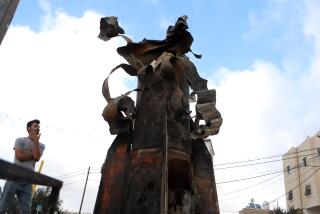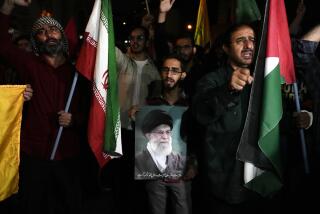Creating the Iran moment
Three decades of assumptions about Iran -- including the premises behind Washington’s recent outreach to Tehran -- have been transformed by its stunning uprising. It’s time for a policy rethink.
The Obama administration’s offer to engage was the right idea. But the theocracy’s brutal crackdown on the opposition since the June 12 presidential election, followed by the purge of senior politicians in show trials and an alarming increase in general executions, marks a turning point for Iran’s revolution. U.S. policy now needs a broader approach. Recent history offers relevant guidelines.
The three most important revolutions of the 20th century -- for their political innovation and impact -- happened in the Soviet Union, China and Iran. At the peak of revolutionary paranoia, the Soviet Union and China witnessed turmoil similar to what is happening today in Iran. Soon afterward, however, Moscow and Beijing altered course. Both began the move from defiant revolutionary regime to a normal state willing to work within the international order and mended relations with the United States.
The shift in both the Soviet Union and China was partly tied to the maturation of revolutions, as Crane Brinton outlined in “The Anatomy of Revolution,” which leads to the final stage of “convalescence” that plays out over years, even decades. The Islamic Republic is on the same trajectory. Its current uprising pits those trying to transform Iran into a normal state against unrelenting revolutionaries. The men and women now on trial have made the transition, in varying degrees, in their political thinking.
In their civil disobedience since June, millions of Iranians also have indicated that they’re ready for normalcy. The U.S. should now factor them into policy.
The pattern of revolutions suggests, however, that a catalyst is required to trigger the critical transition. The spark has traditionally been one of three factors: a geo-strategic challenge, economic necessity or political exigency. In other words, a revolution needing to convert an enemy into an ally to survive.
In the Soviet Union, Josef Stalin launched show trials of Communist Party officials from 1936 to 1938, when vast numbers were dispatched to gulags or executed. Yet pressure from the Nazi threat combined with the costs of war spawned a U.S.-Soviet alliance and Stalin’s meeting with President Franklin D. Roosevelt and British Prime Minister Winston Churchill. Stalin was succeeded by Nikita Khrushchev, who started de-Stalinization. The revolution’s later undoing began after Mikhail Gorbachev concluded that the Soviet system of political control was no longer viable in the information-based global economy and that basic changes were essential to survive.
In the 1960s, China had all the trappings of a rogue state. It defied the international order. It detonated an atomic bomb in 1964. And in 1966, it launched the Cultural Revolution, a period of chaotic political and social upheaval when Mao Tse-tung ruthlessly purged alleged “bourgeois liberals” in the Communist Party. Yet in 1969, the collapse of the Sino-Soviet alliance followed by troop buildups along their mutual border led Mao to consider the realpolitik of normalizing relations with Washington. Henry Kissinger’s secret 1971 trip led to President Nixon’s historic visit in 1972.
Neither Stalin nor Mao became America’s friends. But those encounters -- under conditions of strategic need -- did pave the way for meaningful engagement.
Iran’s three most specific overtures to the U.S. fit the same pattern. In 1986, at a desperate juncture in its war with Iraq, Tehran was willing to deal secretly with both the United States and Israel to acquire weaponry, namely TOW anti-tank missiles. Even after this arms-for-hostages swap was revealed, the regime still sent a secret emissary to the White House to probe further potential.
In the early 1990s, Iran offered the most lucrative petroleum deal in its history to Conoco, to develop offshore oil and gas fields to help pay for postwar reconstruction and modernization demanded by a war-weary population.
In 2001, after the U.S. toppled Afghanistan’s Taliban, Iran cooperated with Washington in crafting a new government. After the U.S. invasion toppled Iraq’s Saddam Hussein in 2003, Tehran put out feelers, prodded partly by the Swiss, about resolving differences with Washington. Flanked by U.S. troops on key borders, Tehran wanted to ensure it was not next.
--
Three U.S. administrations did not exploit opportunities when Iran needed to play and reached out. The challenge now is to create a confluence of factors that will make Tehran again feel that a real deal with Washington is in its interest. Then engagement has a real shot.
Under the current circumstances, it doesn’t.
Diplomacy centered primarily on Iran’s nuclear program is unlikely to work. The regime as well as many protesters view pressure to end uranium enrichment -- a process to provide fuel for peaceful nuclear energy that can be subverted to develop a nuclear weapon -- as a challenge to Iran’s sovereignty and a denial of its economic development. Under the current circumstances, the regime is more likely to engage in a process -- largely to get the world off its back -- that would not produce enduring substance or real resolution.
And if that diplomatic tactic doesn’t work, simply slapping on more international sanctions (given stonewalling by Russia and China on anything tough) also seems unlikely to alone squeeze Iran into cooperation.
Yet a military strike is also likely to backfire, instead rallying Persian nationalism around the regime, just as Saddam Hussein’s 1980 invasion mobilized support for the revolution at a time it was running out of steam.
The Obama administration would be well-advised to step back and recalculate what conditions would lead Iran to feel that the benefits of beginning the transition to a normal state outweigh the costs of sticking to the revolutionary zealotry increasingly rejected by its own people.
More to Read
Sign up for Essential California
The most important California stories and recommendations in your inbox every morning.
You may occasionally receive promotional content from the Los Angeles Times.










